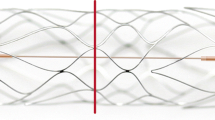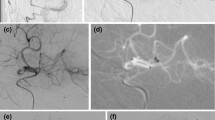Abstract
Purpose
Intra-arterial therapy of acute ischemic stroke has developed rapidly in recent years. Due to proven efficacy in randomized trials, stent retrievers were replacing first-generation thrombectomy devices and have been defined as method of choice. However, aspiration catheters or a combination of several techniques have shown promising rates of successful recanalizations. To create a basis for comparison of the new approaches according to real-world data, we determined the first pass recanalization rate of an evidence-based standard technique with the use of a stent retriever in combination with a balloon-guiding catheter. The assessment was based on the number of required passages and reperfusion rate, but not on clinical results.
Methods
Patients from our institution with anterior circulation occlusions and mechanical thrombectomy by using stent retrievers in combination with balloon-guiding catheters were analyzed retrospectively. Reperfusion was graded with the “thrombolysis in cerebral infarction” (TICI) classification on post-interventional angiograms. Additionally, the number of passes and the duration of the recanalization procedure were recorded.
Results
Between 2014 and July 2017, 201 patients met the inclusion criteria. Successful recanalization, defined as a TICI scale 2b/3, was 91% (TICI 2b was achieved in 44% and TICI 3 in 47%) after the procedure. After the first passage, successful recanalization was achieved in 65% of the patients. Mean number of passes was 1.4 (1–5 passes) for all patients. Median duration of the procedure was 49 min (0:11–2:35 h).
Conclusions
Even a standard thrombectomy technique with the use of a stent retriever together with a balloon-guiding catheter provides reasonable recanalization rates with only one passage. The results can be taken as benchmark for alternative and more complex techniques.
Similar content being viewed by others
References
Jauch EC, Saver JL, Adams HP Jr, et al. Guidelines for the early management of patients with acute ischemic stroke: a guideline for healthcare professionals from the American Heart Association/American Stroke Association. Stroke. 2013;44:870–947.
Berkhemer OA, Fransen PS, Beumer D, et al. A randomized trial of intraarterial treatment for acute ischemic stroke. New Engl J Med. 2015;372:11–20.
Campbell BC, Mitchell PJ, Kleinig TJ, et al. Endovascular therapy for ischemic stroke with perfusion-imaging selection. New Engl J Med. 2015;372:1009–18.
Goyal M, Demchuk AM, Menon BK, et al. Randomized assessment of rapid endovascular treatment of ischemic stroke. New Engl J Med. 2015;372:1019–30.
Saver JL, Goyal M, Bonafe A, et al. Stent-retriever thrombectomy after intravenous t-PA vs. t-PA alone in stroke. New Engl J Med. 2015;372:2285–95.
Jovin TG, Chamorro A, Cobo E, et al. Thrombectomy within 8 hours after symptom onset in ischemic stroke. New Engl J Med. 2015;372:2296–306.
Wahlgren N, Moreira T, Michel P, et al. Mechanical thrombectomy in acute ischemic stroke: consensus statement by ESO-Karolinska Stroke Update 2014/2015, supported by ESO, ESMINT, ESNR and EAN. Int J Stroke. 2016;11:134–47.
Powers WJ, Derdeyn CP, Biller J, et al. 2015 American Heart Association/American Stroke Association focused update of the 2013 guidelines for the early management of patients with acute ischemic stroke regarding endovascular treatment: a guideline for healthcare professionals from the American Heart Association/American Stroke Association. Stroke. 2015;46:3020–35.
Casaubon LK, Boulanger J-M, Blacquiere D, et al. Canadian stroke best practice recommendations: hyperacute stroke care guidelines, update 2015. Int J Stroke. 2015;10:924–40.
Campbell BCV, Hill MD, Rubiera M, et al. Safety and efficacy of solitaire stent thrombectomy: individual patient data meta-analysis of randomized trials. Stroke. 2016;47:798–806.
Saposnik G, Lebovic G, Demchuk A, et al. Added benefit of stent retriever technology for acute ischemic stroke: a pooled analysis of the NINDS tPA, SWIFT, and STAR trials. Neurosurgery. 2015;77:454–61.
Grech R, Mizzi A, Pullicino R, Thornton J, Downer J. Functional outcomes and recanalization rates of stent retrievers in acute ischaemic stroke: a systematic review and meta-analysis. Neuroradiol J. 2015;28:152–71.
Wong JH, Do HM, Telischak NA, et al. Initial experience with SOFIA as an intermediate catheter in mechanical thrombectomy for acute ischemic stroke. J Neurointervent Surg. 2017;9:1103–6. https://doi.org/10.1136/neurintsurg-2016-012750
Delgado Almandoz JE, Kayan Y, Young ML, et al. Comparison of clinical outcomes in patients with acute ischemic strokes treated with mechanical thrombectomy using either Solumbra or ADAPT techniques. J Neurointervent Surg. 2016;8:1123–8.
Lapergue B, Blanc R, Guedin P, et al. A direct aspiration, first pass technique (ADAPT) versus stent retrievers for acute stroke therapy: an observational comparative study. AJNR Am J Neuroradiol. 2016;37:1860–5.
Madjidyar J, Hermes J, Freitag-Wolf S, Jansen O. Stent-thrombus interaction and the influence of aspiration on mechanical thrombectomy: evaluation of different stent retrievers in a circulation model. Neuroradiology. 2015;57:791–7.
Turk AS, Frei D, Fiorella D, et al. ADAPT FAST study: a direct aspiration first pass technique for acute stroke thrombectomy. J Neurointervent Surg. 2014;6:260–4.
Lozano JD, Massari F, Howk MC, et al. Utilization of a new intracranial support catheter as an intermediate aspiration catheter in the treatment of acute ischemic stroke: technical report on initial experience. Cureus. 2016;8:e617. https://doi.org/10.7759/cureus.617
Kang DH. Endovascular stroke therapy focused on stent retriever thrombectomy and direct clot aspiration: historical review and modern application. J Korean Neurosurg Soc. 2017;60:335–47.
Chueh J-Y, Puri AS, Wakhloo AK, Gounis MJ. Risk of distal embolization with stent retriever thrombectomy and ADAPT. J Neurointervent Surg. 2016;8:197–202. https://doi.org/10.1136/neurintsurg-2014-011491
Maus V, Behme D, Kabbasch C, et al. Maximizing first-pass complete reperfusion with SAVE. Clin Neuroradiol. 2017. https://doi.org/10.1007/s00062-017-0566-z
Fields JD, Lindsay K, Liu KC, Nesbit GM, Lutsep HL. Mechanical thrombectomy for the treatment of acute ischemic stroke. Expert Rev Cardiovasc Ther. 2010;8:581–92.
Fugate JE, Klunder AM, Kallmes DF. What is meant by “TICI”? AJNR Am J Neuroradiol. 2013;34:1792–7.
Lapergue B, Blanc R, Gory B, et al. Effect of endovascular contact aspiration vs stent retriever on revascularization in patients with acute ischemic stroke and large vessel occlusion: the ASTER randomized clinical trial. JAMA. 2017;318:443–52.
Mueller-Kronast NH, Zaidat OO, Froehler MT, et al. Systematic evaluation of patients treated with neurothrombectomy devices for acute ischemic stroke: primary results of the STRATIS registry. Stroke. 2017;48:2760–8.
Campbell BCV, Donnan GA, Lees KR, et al. Endovascular stent thrombectomy: the new standard of care for large vessel ischaemic stroke. Lancet Neurol. 2015;14:846–54.
Matsumoto H, Nishiyama H, Tetsuo Y, Takemoto H, Nakao N. Initial clinical experience using the two-stage aspiration technique (TSAT) with proximal flow arrest by a balloon guiding catheter for acute ischemic stroke of the anterior circulation. J Neurointervent Surg. 2017;9:1160–5. https://doi.org/10.1136/neurintsurg-2016-012787
McTaggart RA, Tung EL, Yaghi S, et al. Continuous aspiration prior to intracranial vascular embolectomy (CAPTIVE): a technique which improves outcomes. J Neurointervent Surg. 2017;9:1154–59. https://doi.org/10.1136/neurintsurg-2016-012838
Mohlenbruch MA, Kabbasch C, Kowoll A, et al. Multicenter experience with the new SOFIA Plus catheter as a primary local aspiration catheter for acute stroke thrombectomy. J Neurointervent Surg. 2017;9:1223–7. https://doi.org/10.1136/neurintsurg-2016-012812
Prothmann S, Friedrich B, Boeckh-Behrens T, et al. Aspiration thrombectomy in clinical routine interventional stroke treatment: is this the end of the stent retriever era? Clin Neuroradiol. 2017. https://doi.org/10.1007/s00062-016-0555-7
Stapleton CJ, Torok CM, Patel AB. 110 Noninferiority of a direct aspiration first-pass technique vs stent retriever thrombectomy in emergent large-vessel intracranial occlusions. Neurosurgery. 2016;63(Suppl 1):146–7.
Wei D, Mascitelli JR, Nistal DA, et al. The use and utility of aspiration thrombectomy in acute ischemic stroke: a systematic review and meta-analysis. AJNR Am J Neuroradiol. 2017;38:1978–83.
Jansen O, Macho JM, Killer-Oberpfalzer M, Liebeskind D, Wahlgren N. Neurothrombectomy for the treatment of acute ischemic stroke: results from the TREVO Study. Cerebrovasc Dis. 2013;36:218–25.
Vidal GA, Milburn JM. The penumbra 5MAX ACE catheter is safe, efficient, and cost saving as a primary mechanical thrombectomy device for large vessel occlusions in acute ischemic stroke. Ochsner J. 2016;16:486–91.
Premat K, Bartolini B, Baronnet-Chauvet F, et al. Single-center experience using the 3MAX reperfusion catheter for the treatment of acute ischemic stroke with distal arterial occlusions. Clin Neuroradiol. 2017. https://doi.org/10.1007/s00062-017-0594-8
Maegerlein C, Prothmann S, Lucia KE, Zimmer C, Friedrich B, Kaesmacher J. Intraprocedural thrombus fragmentation during interventional stroke treatment: a comparison of direct thrombus aspiration and stent retriever thrombectomy. Cardiovasc Intervent Radiol. 2017;40:987–93.
Hesse AC, Behme D, Kemmling A, et al. Comparing different thrombectomy techniques in five large-volume centers: a ‘real world’ observational study. J Neurointerv Surg. 2017. https://doi.org/10.1136/neurintsurg-2017-013394
Blanc R, Redjem H, Ciccio G, et al. Predictors of the aspiration component success of a direct aspiration first pass technique (ADAPT) for the endovascular treatment of stroke reperfusion strategy in anterior circulation acute stroke. Stroke. 2017;48:1588–93.
Vargas J, Spiotta AM, Fargen K, Turner RD, Chaudry I, Turk A. Experience with ADAPT for thrombectomy in distal cerebral artery occlusions causing acute ischemic stroke. World Neurosurg. 2017;99:31–36. https://doi.org/10.1016/j.wneu.2016.11.035
Nogueira RG, Jadhav AP, Haussen DC, et al. Thrombectomy 6 to 24 hours after stroke with a mismatch between deficit and infarct. New Engl J Med. 2017;378:11–21.
Zaidat OO, Castonguay AC, Nogueira RG, et al. TREVO stent-retriever mechanical thrombectomy for acute ischemic stroke secondary to large vessel occlusion registry. J Neurointerv Surg. 2017. https://doi.org/10.1136/neurintsurg-2017-013328
Romano DG, Cioni S, Vinci SL, et al. Thromboaspiration technique as first approach for endovascular treatment of acute ischemic stroke: initial experience at nine Italian stroke centers. J Neurointervent Surg. 2017;9:6–10.
Kabbasch C, Mohlenbruch M, Stampfl S, Mpotsaris A, Behme D, Liebig T. First-line lesional aspiration in acute stroke thrombectomy using a novel intermediate catheter: initial experiences with the SOFIA. Intervent Neuroradiol. 2016;22:333–9.
Jankowitz B, Grandhi R, Horev A, et al. Primary manual aspiration thrombectomy (MAT) for acute ischemic stroke: safety, feasibility and outcomes in 112 consecutive patients. J Neurointervent Surg. 2015;7:27–31.
Vargas J, Spiotta A, Fargen K, Turner R, Chaudry I, Turk A. Long term experience using the ADAPT technique for the treatment of acute ischemic stroke. J Neurointervent Surg. 2017;9:437–41.
Peschillo S, Diana F, Colonnese C, et al. Real-time distal, multifocal, repeated lenticulostriate bleeding points during thrombectomy in a patient with acute variable M1 occlusion: a case report and a literature review. J Stroke Cerebrovasc Dis. 2017;26:2082–6.
Jeong EO, Kwon HJ, Choi SW, Koh HS. Pseudoaneurysm formation after repetitive suction thrombectomy using a penumbra suction catheter. J Cerebrovasc Endovasc Neurosurg. 2016;18:296–301.
Brinjikji W, Starke RM, Murad MH, et al. Impact of balloon guide catheter on technical and clinical outcomes: a systematic review and meta-analysis. J Neurointerv Surg. 2017. https://doi.org/10.1136/neurintsurg-2017-013179
Author information
Authors and Affiliations
Corresponding author
Ethics declarations
Conflict of interest
The authors declare that they have no conflict of interest.
Ethical Approval
For this type of study formal consent is not required.
Informed Consent
Written informed consent was waived by the institutional review board.
Rights and permissions
About this article
Cite this article
Kammerer, S., du Mesnil de Rochemont, R., Wagner, M. et al. Efficacy of Mechanical Thrombectomy Using Stent Retriever and Balloon-Guiding Catheter. Cardiovasc Intervent Radiol 41, 699–705 (2018). https://doi.org/10.1007/s00270-018-1901-8
Received:
Accepted:
Published:
Issue Date:
DOI: https://doi.org/10.1007/s00270-018-1901-8




